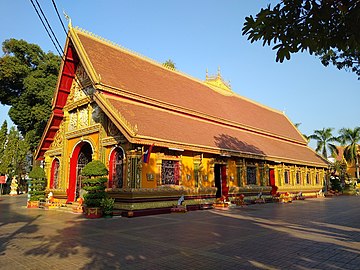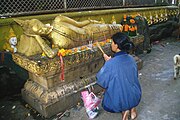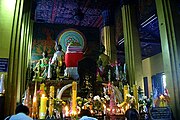
Wat Si Muang or Simuong (Lao: ວັດສີເມືອງ) is a Buddhist temple in Vientiane, the capital of Laos.
History[edit]
The temple was built in 1563, in the former Kingdom of Lan Xang.

A statue of King Sisavang Vong stands in front of Wat Simuang.
There is a legend that pregnant women at the time of construction were given to as sacrifice to God.[1]
Description[edit]
Inside, the temple is unusual in being divided into two rooms. The front room is quiet, with a monk usually on hand to give blessings. The rear room houses the large main altar, with statues and images of the Buddha.[2]
Gallery[edit]
References[edit]
- ^ "ASEAN GUIDE LAOS" (PDF). Archived (PDF) from the original on 28 September 2011. Retrieved 17 August 2011.
- ^ "Asiaforvisitors.com - A guide to Laos". Archived from the original on 8 December 2010. Retrieved 20 February 2008.
17°57′28″N 102°37′02″E / 17.9579°N 102.6171°E




Well, that’s interesting to know that Psilotum nudum are known as whisk ferns. Psilotum nudum is the commoner species of the two. While the P. flaccidum is a rare species and is found in the tropical islands. Both the species are usually epiphytic in habit and grow upon tree ferns. These species may also be terrestrial and grow in humus or in the crevices of the rocks.
View the detailed Guide of Psilotum nudum: Detailed Study Of Psilotum Nudum (Whisk Fern), Classification, Anatomy, Reproduction